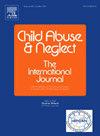Coexisting patterns of posttraumatic stress disorder and depression symptoms in college students who experienced childhood maltreatment: Different types of maltreatment exposure
IF 3.4
2区 心理学
Q1 FAMILY STUDIES
引用次数: 0
Abstract
Background
Childhood maltreatment is often associated with comorbid posttraumatic stress disorder (PTSD) and depression, but the impact of different types of maltreatment on this comorbidity is not well understood.
Methods
Using network analysis, we examined differences in comorbidity patterns of PTSD and depression symptoms among college students who experienced different forms of childhood maltreatment. We selected a subsample of 2968 students (Mage = 19.38, SD = ±1.45) who reported exposure to childhood maltreatment from a larger sample of 5231 students.
Results
This study showed that symptoms of negative emotions and cognitive change, intrusive symptoms, and increased alertness might play a significant role in the diagnosis and prognosis of comorbid PTSD and depression. The most central nodes in the network of physical maltreatment were flashbacks, and irritability, whereas the most central nodes in the network of emotional and compound trauma, were low mood and sadness. Moreover, network structure and strength differed significantly between maltreatment types, and differences in specific symptom associations were also observed.
Conclusion
Network analysis provides insights into which symptoms contribute to the development of comorbidities in individuals with different childhood maltreatment types, as well as how specific symptoms are interconnected in the network. This information can aid in developing targeted and effective interventions for different maltreatment forms.
经历过童年虐待的大学生创伤后应激障碍和抑郁症状的共存模式:不同类型的虐待暴露
儿童虐待通常与创伤后应激障碍(PTSD)和抑郁症共病有关,但不同类型的虐待对这种共病的影响尚不清楚。方法采用网络分析的方法,对经历过不同形式童年虐待的大学生PTSD共病模式和抑郁症状的差异进行研究。我们从5231名学生的大样本中选择了2968名学生(Mage = 19.38, SD =±1.45),这些学生报告了童年虐待。结果负性情绪和认知改变症状、侵入性症状和警觉性增高可能对PTSD合并抑郁症的诊断和预后有重要影响。身体虐待网络的主要中心节点是闪回和易怒,而情绪和复合创伤网络的主要中心节点是情绪低落和悲伤。此外,网络结构和强度在虐待类型之间存在显著差异,在特定症状关联方面也存在差异。结论网络分析有助于了解不同儿童虐待类型个体中哪些症状导致了合并症的发展,以及特定症状如何在网络中相互关联。这些信息有助于针对不同形式的虐待制定有针对性和有效的干预措施。
本文章由计算机程序翻译,如有差异,请以英文原文为准。
求助全文
约1分钟内获得全文
求助全文
来源期刊

Child Abuse & Neglect
Multiple-
CiteScore
7.40
自引率
10.40%
发文量
397
期刊介绍:
Official Publication of the International Society for Prevention of Child Abuse and Neglect. Child Abuse & Neglect The International Journal, provides an international, multidisciplinary forum on all aspects of child abuse and neglect, with special emphasis on prevention and treatment; the scope extends further to all those aspects of life which either favor or hinder child development. While contributions will primarily be from the fields of psychology, psychiatry, social work, medicine, nursing, law enforcement, legislature, education, and anthropology, the Journal encourages the concerned lay individual and child-oriented advocate organizations to contribute.
 求助内容:
求助内容: 应助结果提醒方式:
应助结果提醒方式:


